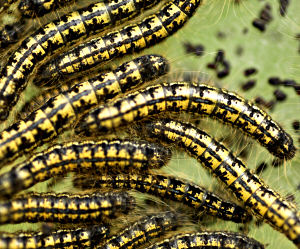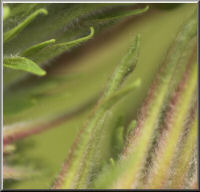|
|


Cooking oils are highly processed,
using manufacturing methods that are destructive to oil
molecules. These practices are
utilized primarily to lengthen and stabilize the shelf life
of oils. Because many people are unaware of the methods used
to make these oils, I thought I would offer an explanation
of the cooking oil industry's manufacturing secrets.
After oils are pressed or solvent
extracted from seeds and nuts, they are degummed, refined,
bleached, and deodorized. The result is known as an RBD (refined, bleached, deodorized
oil) and these oils, as a result, become colorless, odorless,
and tasteless. Sellers recommend these oils for salads, baking,
and frying.
What many people don't know is that
valuable 'minor ingredients' including antioxidants, phytosterols, chlorophyll, flavor
molecules, color molecules, lecithin, and other oil-soluble
beneficial molecules are removed too. |
| |
| In
addition, 0.5 to 1% of the oil molecules themselves are
damaged during the processing. Some of these molecules
have been isolated, tested with animals, and found to be
very toxic. The damaged molecules found in cooking oils
are much more toxic than the trans- fats which, according
to the Harvard School of Public Health, double the risk
of heart attacks, kill at least 30,000 people in the US
every year, and increase diabetes. |
| |
- NaOH
(a very corrosive base used to burn clogged sink and
drain pipes open). NaOH is used to remove the natural,
alkali-soluble 'minor ingredients' from the oil. These
minor ingredients are good for health, but diminish
product shelf life and that is why manufacturers choose
to remove them from the oil and discard them.
- H3PO4
(a very corrosive acid used commercially for degreasing
windows). H3PO4 removes the acid-soluble 'minor ingredients'.
Again, for the sake of longer shelf life, which makes
larger market gains, fewer returns due to spoilage,
and greater profits, these natural molecules with health
benefits are removed.
- Bleaching
clays are used which damage the molecules that give
oil its color. Because the color molecules absorb light,
and subsequently, the light then damages oil molecules,
this process is carried out to obtain greater shelf
stability at the expense of health benefits. Unfortunately,
bleaching produces rancidity, which imparts bad odor
to oils. The rancid oil must then be cleaned up to
remove the bad flavor and odor. The oil must be De-odor-ized.
- Deodorization
takes place at frying temperatures (between 220° and
245°C). The bad odors and flavors are removed,
and the oil becomes colorless, odorless, and tasteless,
but these cooking oils are now palatable and have a
long shelf life.
|
|
|
Unfortunately,
many changes happen to oil during these processes used
to improve shelf life and profit. The 'minor ingredients'
with major health benefits are removed, including: 
- Phytosterols, which protect both cardiovascular and immune systems;
- Lecithin,
which emulsifies oils and makes them easier to digest;
- Chlorophyll-a
source of the essential mineral magnesium, which is
required for muscle, heart, and nerve functions, and
is required for insulin function, is used in natural
treatments to reverse and prevent cancer, is involved
in most of the chemical reactions in the body by which
energy is made, and is inadequately present in 80%
of the population; and
- Antioxidants including the essential vitamin E, carotene and others,
which keep oils fresh longer, protect the body from
aging by neutralizing molecular terrorists called 'free
radicals', and thereby inhibiting aging and prolonging
life.
These
'minor ingredients' with major health benefits are removed,
and the oil becomes unbalanced. You can find more detailed
information on the nutrient losses that oils suffer during
processing in my book, Fats That Heal Fats That Kill.
|
| |
| |
In addition
to the removal of beneficial nutrients, 0.5
to 1% of the oil molecules are changed into substances that
have never been present in nature, do not fit into the very
precise molecular architecture of the human (or animal) body,
and therefore have highly toxic effects on life's biochemical
processes.
You might think that the percentage
of these changed molecules is not high, but
given their high toxicity, our daily consumption of such damaged oils, and the
actual number of molecules that comprise this damage ( 0.5 to 1% ), you are looking
at a much more serious concern. Let me do the numbers:
- The
oil in a 32-ounce bottle of cooking oil (1 quart)
weighs about 900 grams. A molecule of oil (called a triglyceride
molecule) has a molecular weight of between 800 and
1,000 (let's average that to 900 to make the math easy).
The rules of physical chemistry tell us that the molecular
weight (900) in grams of a molecule (in this case,
900 grams of oil = triglyceride) (i.e. the 900 grams
of oil found in a 32-ounce bottle) contains about 6.02x1023
molecules.
- That's
a very large number: 602,000,000,000,000,000,000,000
molecules (12 zeros make a trillion, and 9 zero's makes
a billion, so a bottle of oil contains 602 billion trillion
molecules). Of these molecules, if 1% is damaged, it
means there are 6 billion trillion damaged molecules.
If only 0.5% of them are damaged, the number is (only!)
3 billion trillion molecules. How many bottles of cooking
oil used in salads, baked goods, fried foods, and hidden
in other consumed items does a person eating a 'normal'
diet consume in a lifetime?
- At
a conservative estimate of one tablespoon of oil (containing
10 billion trillion molecules, with 1% or 100 million
trillion damaged ones) per day (consumed in salad dressings,
mayonnaise, fried and deep fried foods, and hidden oil
in baked and other prepared foods), a 32-ounce bottle
would last about 2 months. That's six bottles per year.
Fifty years of this consumption is 300 bottles over a
lifetime. This is a conservative estimate. Many people
use substantially more than that.
|
| |
|
Our body contains about 100 trillion cells.
From
one bottle of oil, each of our cells would obtain about
6 billion damaged toxic oil molecules.
Each
daily tablespoon (1% toxic molecules) would provide
100 million toxic molecules per cell per day.
How
many toxic oil molecules would that person eat
over an entire lifetime? At
our estimate, it would be 1,800 billion (or 1.8
trillion damaged, health-destroying molecules).
Studies
with bacteria have shown that only 2 molecules
per cell of certain nutrients are needed to turn
on a gene and to alter cell biochemistry. If
genes are this sensitive to nutrient molecules,
do you suppose that 100 million toxic molecules
beating up each cell could affect your genes and
have effects on the health of that cell? You betcha.
|
|
| |
| The
damaged oil molecules produced by processing 'cooking oils'
include fragmented molecules, double-bond shifted molecules,
trans- fats, cross-linked molecules within triglycerides,
cross-linked molecules across triglycerides, cyclized molecules,
and many other fatty acid aberrations. Some of these have
been tested in animals and found to be very toxic indeed.
Further information on this topic is available in the book,
Fats That Heal Fats That Kill. |
| |
 In
practice, the use of these oils, especially the omega-6 rich
corn and safflower oils, which have been studied for many
years, show a correlation with increased cancer. When 'cooking
oils' are used for cooking (which today means frying), further
damage occurs to the oils by light, oxygen, and high temperature.
Frying is also associated with increased cancer, cardiovascular
disease, and probably inflammatory diseases. |
| |

In supermarkets, all oils except extra
virgin olive oil have been processed by the same destructive methods. Extra virgin
olive oil, while not damaged by processing, is a poor source
of essential fats, and provides less that 1% omega-3 and only
10% omega-6. When extra virgin olive oil is fried, it is extensively
damaged. It should not be used for frying, but should be
added to foods after they come off the heat. The oils that
are processed with a corrosive base, window washing acid,
bleaching clays, and then heated to frying temperatures before
they go in the bottles include corn, safflower, soybean,
canola, and the other oils found on the shelf in supermarkets,
convenience stores, and even health food stores in transparent
glass or plastic bottles. If oil does not say 'unrefined'
on its label, it has been processed by the methods described
above.
Oils
made with health (rather than shelf life) in mind are pressed
from organically grown seeds and nuts, protected from destruction
by light, air (oxygen), and heat during pressing, filtering,
and filling into dark glass bottles.
|
| |

Udo's Choice Oil BlendT has a box around
the brown glass bottle to prevent all light from entering the container. These oils,
made by Flora Inc., are refrigerated in the factory and refrigerated
in stores. They are found in health food stores, gyms, and
the offices of some health practitioners.
We recommend that
you keep the oil refrigerated or frozen at home, and
use it on cold, warm, and hot foods (it's okay in hot soup or
on steamed veggies once these foods are in your bowl
or on your plate). Please never use these oils for frying. All
of the care that is taken to keep them fresh and healthy
is lost in a few minutes in a hot frying pan. The better
the oil is for you, the more toxic it becomes should
you fry with it.
|
| |
|
Hard
fats are less toxic when fried than are liquid oils. From
the point of view of what is best for health, frying cannot
be recommended. Burned food is toxic. No animal eats it.
We also should not eat burned foods if we want to live long
and prosper in good health. |
|
|

|
|
|